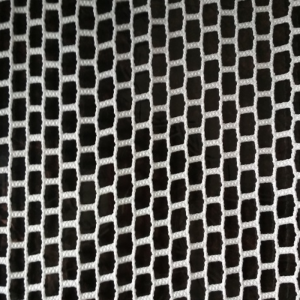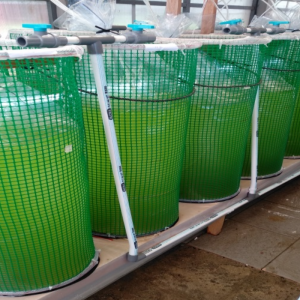
A successful Case of Split Pond Recirculation Aquaculture System (SP-RAS) for Snakehead Fish Farming in Andhra Pradesh of India
| Mon, 02 Nov 2020 - 16:33
The air-breathing snakehead fish (Channa striata) commonly called stripped murrel in India, is one of the most popular freshwater fishes. Live snakehead fish fetches a stable high price between INR 400-500/kg (US $6-8/kg) in different retail markets. Murrel was officially declared as the 'state fish' for Telangana in 2016, which focused upon the promotion of murrel farming and conserving the indigenous aquatic diversity in the water bodies of Telangana.
Considering the need to bring more high value species into aquaculture in India, Uno Feeds, one of India's largest extruded fish feed manufacturers, has entered into a strategic co-operation with Nutriera Group, the biggest integrated aquafeed technology solution provider, to bring the technology for domestication and grow out of snakehead fish in India. Since 2015, Uno Feeds has set up a dedicated hatchery and research facility for breeding snakehead in Bhimavaram, Andhra Pradesh with the assistance of the Nutriera team.
From 2016 to 2019, the commercial scale artificial breeding of snakehead fish was successfully carried out at this facility and the fry was gradually weaned to take specially formulated extruded snakehead feed. The grow-out phase of these weaned seeds was also carried out in several farming areas in West Godavari, East Godavari and Krishna District, widely spread over 100 acres with a 100 percent planned increase in farmed area annually. Throughout the past five years, snakehead fish intensive farming at Uno Feeds has also encountered some farm-end difficulties, such as limited fresh water resources, microcystis bloom, extreme high temperature and severe fish diseases like water moulds and Epizootic Ulcerative Syndrome outbreak during the winter season.
Snakehead fish is a typical carnivorous fish with high level feed nutrition requirements. As the result of the unavailability of the natural water resources for water exchange, the continuous feeding and fish feces bring about worsening water quality, and then microcystis proliferation occurs during farming under the conditions of higher temperature. Fish liver was also noted to be especially vulnerable after encountering with microcystin breakout, which became yellowed and fragile.
Indian Major Carps (IMC)
India is the second largest aquaculture producer in the world after China, and India constitutes about five percent of global fish production. Indian major carps (IMC) catla (Catla catla), rohu (Labeo rohita) and mrigal (Cirrhinus mrigala), the mainstay of freshwater aquaculture species, enjoy a prime position in the Indian aquaculture scenario with a most classical polyculture system and contribute around 80 percent of the total freshwater aquaculture production in India.
Rohu is the most important component of the IMC polyculture system, as it has been reported as both a plankton feeder in adults and zooplankton feeder in fry and fingerlings. Rohu also is a periphyton feeder in substrate base systems (Sandip Majumder, 2016). It has also been reported by Rahman (2008) that, under culture conditions when rohu was fed with formulated feeds, they shifted their natural food preference from phytoplankton to zooplankton.
Monjurul Islam (2014) suggested that rohu fingerlings could be reared in coastal water with salinity of up to six percent with a 100 percent survival rate and up to four percent salinity with a similar growth rate as with freshwater. Catla is the second most important species after rohu, used as the surface feeder component in IMC culture systems, as a surface and midwater feeder. Adults mainly feed on zooplankton using large gill rakers, as well as a considerable share of algal and plant material.
Mrigal, a bottom detritus and plankton eater, forms an important component of polyculture systems with other species of major carps in India. Mrigal has also been introduced to China, whose fingerlings play an important role acting as the live forage fish for the commercial farming of Mandarin fish (Siniperca chuatsi) before the practice of commercial feeds.
As the result of the special biology and feeding habits mentioned above and more than 30 years of farming history, bag feeding (mash feed) is still the dominant feeding model for the IMC polyculture system which comprises of around 85 percent rohu, 10 percent catla and five percent mrigal. De-oiled rice bran (DOB) is used as the principal feed ingredient, followed by groundnut cake and cottonseed cake etc.
Split Pond Recirculation Aquaculture Systems (SP-RAS)
From the above discussion, we can figure out that the water from ponds of snakehead fish and IMC might be complimentary for each other's farming performance, these methods also can make the best use of available water resources. Considering fish biology such as feeding habits, nutrition requirements, oxygen tolerances, growth rates and economic values of the two species (snakehead fish and rohu), we cannot stock the two species in a same pond as a form of polyculture.
Based on the comparative analysis of snakehead fish and IMC, a farming concept that has combined snakehead fish and IMC farming, is Split Pond Recirculation Aquaculture Systems. After some searching and analysis, we selected some fishponds located in Machilipatnam, Andhra Pradesh as the demonstration area to carry out the recirculating aquaculture trials.
SP-RAS design
In the Split Pond Recirculation Aquaculture System, the eutrophied water was pumped from a 0.6ha snakehead fish pond into a 14ha IMC pond at the downwind. Meanwhile, the water from the IMC pond automatically flowed into the snakehead fishpond at upwind through the underground PVC pipe. The water exchange frequency was lower in the first stocking month, changed two-to-three times a week with 30 percent exchange rate, followed by one-to-twice per day, depending upon the water quality status and fish conditions in the mid-to-late crop. In addition, various health products were used to optimise fish health regularly.
Performance of SP-RAS
A 5HP engine was used as the water flow driver. It was installed at the downwind corner of the snakehead fishpond and could pump the water from the snakehead fishpond into the rohu pond. Meanwhile the rohu pond water can flow into the snakehead fishpond to achieve the recirculation purposes through the underground PVC tube.
After one month of implementing this water circulation system, the water quality of the snakehead fishpond was much better than before. As evidence of this, the microcystis density was diluted distinctly more. Furthermore, the bottom black sludge thickness was reduced from 30cm to 20cm within one month of implementation of the system. Fish appetite also returned to their normal voracious status after their liver conditions recovered to normal with the help of functional health care products LiverGuard and AyurGuard (mixing with feed 0.5-1% dosage, supplied twice a week).
Water quality parameters varied between the two ponds when running the SP-RAS. It was found that IMC pond water quality was better than snakehead fishponds consistently through this trial.
Snakehead fish growth performance and feed conversion ratio (FCR) is shown in the Graph 1. Before running SP-RAS, the culture environment was deteriorated with microcystis bloom resulting in fish with sub-healthy conditions. This led to poor feed utilization levels. After running the recirculation system, accompanied with proper health control solutions, after one month, fish health conditions and feed utilisation were improved significantly.
The prospect of SP-RAS
Based on the successful practice, one can easily come to a conclusion that the SP-RAS can improve the farming performance of IMC and snakehead. It can also reduce the water usage and assist in the implementation of zero waste-water discharge. This form of polyculture helps to develop global aquaculture with a minimised environmental footprint as it is an environment-friendly farming practice which also can be used for other species such as Penaeus vannamei and IMC, Asian seabass and IMC, for example.
The China-ASEAN Fisheries Resources Conservation and Exploitation Fund is supporting more researches on novel farming practices with suitable stocking density and environment influence, as well as application of farm care product and functional feeds for SP-RAS.






















